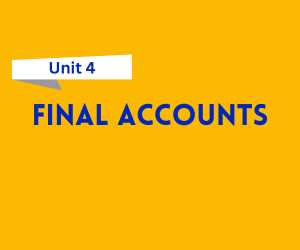Welcome to Unit 4 of Financial Accounting, where you’ll explore how a sole proprietorship prepares its final accounts—a crucial part of any business’s financial reporting.
This unit will teach you how to prepare and understand the Trading Account, Profit and Loss Account, and Balance Sheet—as well as how to incorporate key adjustments like outstanding expenses, depreciation, and more.

Download Unit 4 – Final Accounts of Sole Proprietorship Notes
Download your Unit 4 Financial Accounting Notes in PDF format – designed especially for BBA 1st Semester students:
⬇️
Download Unit 4 Notes PDF
What are Final Accounts?
Final accounts refer to the financial statements that are prepared at the end of an accounting period to determine the net result (profit or loss) and financial position of the business.
In a sole proprietorship, the final accounts include:
Trading Account
Profit and Loss Account
Balance Sheet
(a) Trading Account
The Trading Account shows the gross profit or gross loss made by the business through buying and selling goods.
Formula:
Gross Profit = Net Sales – Cost of Goods Sold
It includes:
Opening stock
Purchases (less returns)
Direct expenses (e.g., carriage inwards, wages)
Sales (less returns)
(b) Profit and Loss Account
The Profit and Loss Account calculates the net profit or loss by accounting for all indirect incomes and expenses.
It includes:
Indirect expenses: salaries, rent, electricity, depreciation
Other incomes: interest received, commission
Formula:
Net Profit = Gross Profit + Other Incomes – Indirect Expenses
(c) Balance Sheet
The Balance Sheet is a statement of the financial position of the business on a particular date.
It shows:
Assets (fixed & current): cash, debtors, machinery, stock
Liabilities: creditors, outstanding expenses, loans
Capital: adjusted with net profit or loss and drawings
Assets = Liabilities + Capital
The balance sheet must always balance!
Adjustments in Final Accounts
To reflect the true financial condition, several adjustments are made before finalizing accounts:
1. Outstanding Expenses
Expenses incurred but not yet paid
→ Added to the related expense & shown as liability
2. Prepaid Expenses
Expenses paid in advance
→ Deducted from expense & shown as asset
3. Accrued Income
Income earned but not received
→ Added to income & shown as asset
4. Income Received in Advance
Income received but not yet earned
→ Deducted from income & shown as liability
5. Depreciation
Reduction in value of fixed assets
→ Shown as expense in P&L and deducted from asset in Balance Sheet
6. Bad Debts
Irrecoverable part of accounts receivable
→ Shown as expense & deducted from debtors
7. Provisions
Set aside for future expected losses (e.g., doubtful debts)
→ Deducted from income or added to expenses
These adjustments ensure the accuracy and completeness of final accounts and help in true and fair presentation.
Why This Unit Matters
Learning how to prepare final accounts equips you with practical accounting skills. Whether you’re working on assignments, internships, or starting a business, this unit builds a solid base for financial decision-making.
